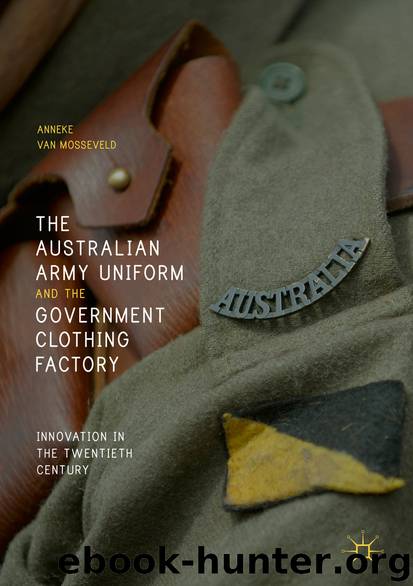The Australian Army Uniform and the Government Clothing Factory by Anneke van Mosseveld

Author:Anneke van Mosseveld
Language: eng
Format: epub
Publisher: Springer International Publishing, Cham
Fig. 7.5Cotton production in Australia, 1920–2000. Note: Fig. 7.4 is a close-up view of a section of Fig. 7.5. The latter depicts billions of pounds of cotton produced, making it appear as if there was no cotton production between 1920 and 1960. The close-up view rectifies this
Improvements in Textile and Clothing Manufacturing Techniques
The business of making Army uniforms is closely linked with the clothing and textile industry as a whole and any developments altering the nature of the latter had an impact upon the former. As new technology and other innovative changes entered the industry—even if patchy at times and only affecting some firms while others lagged behind—the uniform business similarly adopted the changes. At times, the Australian Government Clothing Factory was ahead of the clothing industry in using the latest available technology. There were occasions when the Australian Army led the way in the methods specified for the construction of the uniforms, which in turn forced subcontracting firms to purchase the necessary machines, such as buttonhole machines, or to lay the patterns in a certain way upon the fabric which had been calculated as the most economical way and reduced the fabric cost of each garment. However, the new technology or innovative changes usually emanated from external sources and were subsequently taken on board when firms were ready to do so.
For an appreciation of the developments within the textile and clothing industry during the twentieth century, it is best to do a stocktake of the overall position by the end of that century and relate this to the conditions prevailing a hundred years or so earlier. When the Industry Commission reported on the textile, clothing and footwear (TCF) industries in 1997 it marked the sector as much more efficient in its operations due to an increase in technology and labour-saving techniques, increased quality, increases in staff skills, the use of independent contractors and homeworkers, sourcing part of the product from offshore locations and introducing changes in management techniques, especially the use of quick response supply systems and rationalisation of production.62 In the clothing industry, the most remarkable technological changes were the use of computer-programmable sewing machines, CAD (Computer Aided Design) systems to draft patterns and layouts, CNC (Computer Numerically Controlled) cutting systems, EDI (Electronic Data Interchange) and modern warehousing and distribution systems.63 The smaller firms, in particular, would have lacked the financial resources to invest in expensive CAD and cutting systems and the Industry Commission noted that only one in three manufacturers in the TCF sector undertook technological innovation between 1991 and 1994.64
In 1971, the government had built a ‘state of the art’ Clothing Factory in Coburg, Victoria, to replace the old factory at South Melbourne. The new factory was the first in Australia to install a computerised cutting system, a Gerber S90 imported from the USA, linked to a CAD system in a separate room on which the patterns were designed and laid out on screen in the most efficient manner. An original cardboard pattern showing each pattern
Download
This site does not store any files on its server. We only index and link to content provided by other sites. Please contact the content providers to delete copyright contents if any and email us, we'll remove relevant links or contents immediately.
International Integration of the Brazilian Economy by Elias C. Grivoyannis(90624)
The Radium Girls by Kate Moore(11921)
Turbulence by E. J. Noyes(7935)
Nudge - Improving Decisions about Health, Wealth, and Happiness by Thaler Sunstein(7613)
The Black Swan by Nassim Nicholas Taleb(7009)
Rich Dad Poor Dad by Robert T. Kiyosaki(6398)
Pioneering Portfolio Management by David F. Swensen(6226)
Man-made Catastrophes and Risk Information Concealment by Dmitry Chernov & Didier Sornette(5921)
Zero to One by Peter Thiel(5684)
Secrecy World by Jake Bernstein(4640)
Millionaire: The Philanderer, Gambler, and Duelist Who Invented Modern Finance by Janet Gleeson(4374)
The Age of Surveillance Capitalism by Shoshana Zuboff(4208)
Skin in the Game by Nassim Nicholas Taleb(4161)
Bullshit Jobs by David Graeber(4094)
The Money Culture by Michael Lewis(4073)
Skin in the Game: Hidden Asymmetries in Daily Life by Nassim Nicholas Taleb(3929)
The Dhandho Investor by Mohnish Pabrai(3698)
The Wisdom of Finance by Mihir Desai(3649)
Blockchain Basics by Daniel Drescher(3495)
